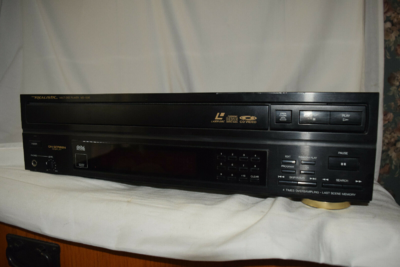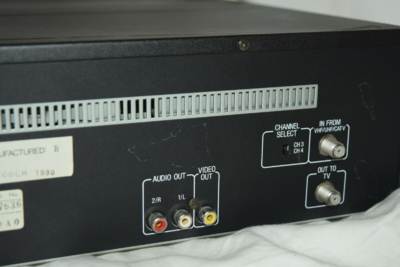Realistic MD-1000: Difference between revisions
Jump to navigation
Jump to search
No edit summary |
No edit summary |
||
| Line 1: | Line 1: | ||
{{LaserDisc Player | {{LaserDisc Player | ||
|manufacturer=Realistic | |manufacturer=Realistic | ||
|releasedate= | |releasedate=October 1990 | ||
|country=US | |country=US | ||
|altmodels=Funai MD-K55 | |altmodels=Funai MD-K55 | ||
Latest revision as of 12:42, 5 December 2020
| Release Info | |
|---|---|
| Manufacturer | Realistic |
| Release Date | October 1990 |
| Country | US |
| Color Encoding System | NTSC |
| Features | |
| Playable Disc Formats | LD, CD |
| Playable LaserDisc Modes | CAV, CLV |
| Both-Side Play | None |
| CX Noise Reduction | No |
| Video Characteristics | |
| Horizontal Resolution (TVL) | 425 lines |
| Video Signal-to-Noise Ratio | 47dB |
| Laser Type | |
| Laser Wavelength | |
| Digital Video Processor | None |
| Analog Audio Characteristics | |
| Frequency Response | 20-20,000Hz |
| Signal-to-Noise Ratio | 90dB |
| Digital Audio Characteristics | |
| Frequency Response | |
| Signal-to-Noise Ratio | |
| Power Characteristics | |
| Input Voltage | |
| Power Frequency | |
| Power Consumption | |
| Physical Characteristics | |
| Dimensions (W x H x D) | 17 x 4 7/8 x 15 1/2 |
| Weight | 19lb |
| Loading Belt Part No. | |
| Accessories | |
| Remote Control | |
Clone Model Numbers/Rebadges
Manuals
Technical Data References
Other Information
The Tandy/Realistic MD-1000 was manufactured for Tandy's Radio Shack between 1989 and 1991 and may have been manufactured by Funai Electric Co. Ltd.
The MD-1000 is similar to the Funai MD-K55, especially on the rear connections of the unit, but for one exception, the "S Video" jack is missing on the location where it would have been. Both players have a plastic/adhesive covering on the rear panel, thus suspecting a "stripped" unit to save costs and covering the numerous amount of terminal holes in the rear.
The identification label at the rear has the word custom misspelled as "costom" ( "COSTOM MANUFACTURED FOR RADIO SHACK...." ).[1]











